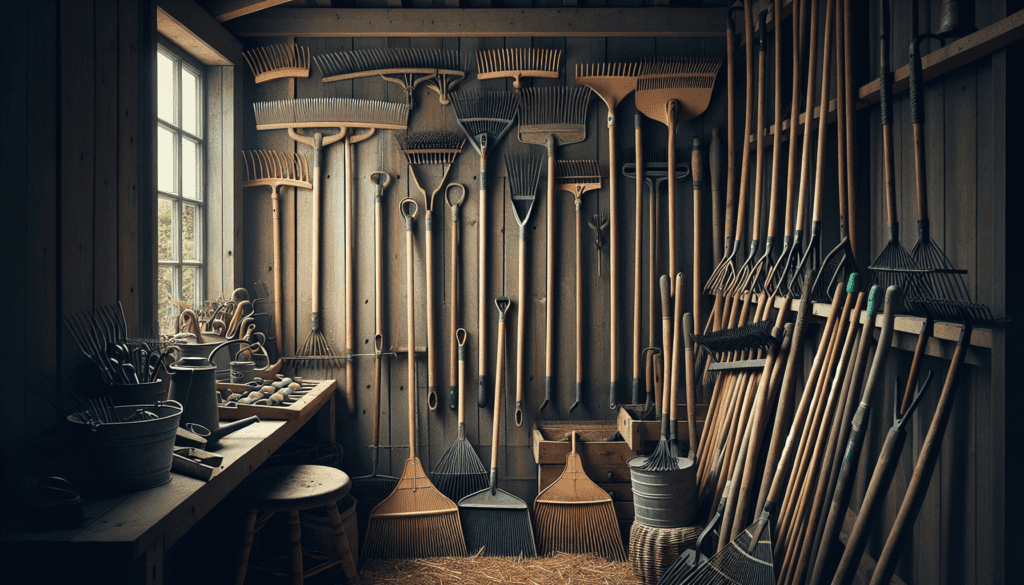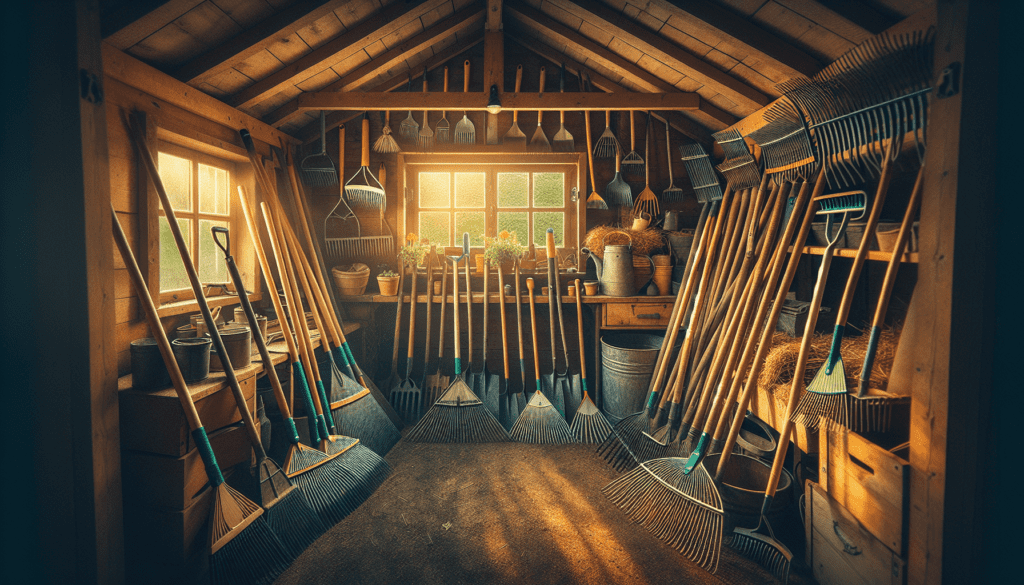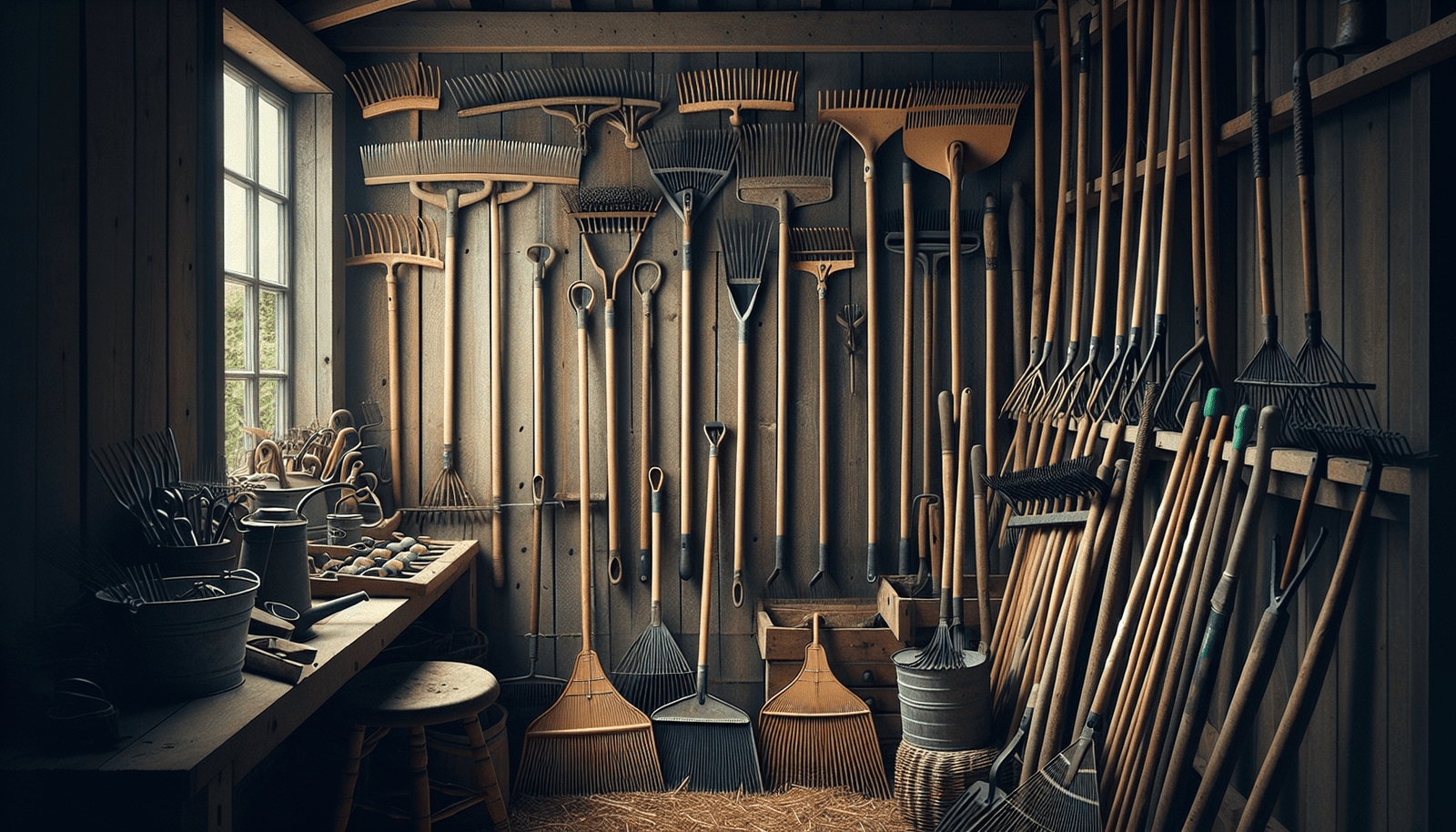Looking to find the perfect garden rake for your outdoor projects? Look no further! In this article, we’ll explore the best garden rakes for different tasks, helping you choose the right tool to make your gardening endeavors a breeze. Whether you’re raking leaves, spreading mulch, or removing debris from your lawn, we’ve got you covered. With our suggestions, you’ll be able to effortlessly maintain a tidy and beautiful garden all year round. So let’s get started and find the perfect rake for your gardening needs!
Leaf Rakes
Leaf rakes are essential tools for maintaining a clean and tidy outdoor space, especially during the fall season when leaves start to cover the ground. There are several types of leaf rakes available, each designed to cater to different needs and preferences. In this section, we will explore three popular types of leaf rakes: flexible tined, adjustable, and wide head leaf rakes.
Flexible Tined Leaf Rakes
Flexible tined leaf rakes are known for their versatility and efficiency in collecting leaves and other garden debris. The flexible tines allow for better maneuverability and make it easier to collect leaves without damaging the underlying grass or soil. These rakes are usually made of durable materials such as steel or hard plastic, ensuring their longevity and effectiveness in tackling your leaf clean-up tasks.
Adjustable Leaf Rakes
If you’re looking for a rake that offers flexibility in terms of width, then adjustable leaf rakes are the perfect choice. These rakes typically feature adjustable tines that allow you to change the width of the rake head depending on your needs. This feature is particularly useful when working in tight or hard-to-reach areas. With an adjustable leaf rake, you can easily switch between narrower or wider settings to accommodate different clean-up tasks.
Wide Head Leaf Rakes
For larger outdoor spaces or areas with lots of leaves, a wide head leaf rake can be a game-changer. These rakes come with a broader rake head, enabling you to cover a larger surface area with each stroke. Wide head leaf rakes are excellent for quickly gathering leaves and debris, making them a time-saving option for those with extensive gardens or yards. Their sturdy construction ensures durability, even when handling heavier loads of leaves.
Lawn Rakes
Maintaining a healthy and vibrant lawn requires regular maintenance, and having the right tools is key to achieving the desired results. When it comes to raking your lawn, three specific types of lawn rakes stand out: thatch rakes, bowler rakes, and spring rakes.
Thatch Rakes
Thatch rakes are specifically designed to remove thatch, which is a layer of dead grass and other organic debris that accumulates on the surface of the soil. Excessive thatch can hinder the growth of healthy grass by preventing water, nutrients, and air from reaching the roots. Thatch rakes have sharp, curved tines that penetrate the thatch layer and effectively lift it away, promoting a healthier and more vibrant lawn.
Bowler Rakes
Bowler rakes, also known as flat tine rakes, are excellent for general lawn maintenance tasks such as raking leaves, removing debris, and preparing the soil for planting. These rakes feature flat, straight tines that make it easier to rake through grass without damaging it. Whether you need to clear fallen leaves or level the soil before planting, a bowler rake is a versatile option for maintaining a well-groomed lawn.
Spring Rakes
Spring rakes, also known as spring-bow rakes, are designed with a flexible spring steel head and curved tines. This unique construction allows for better control and reduces the effort required when raking. Spring rakes are particularly useful for removing leaves and grass clippings from lawns without damaging the underlying soil. The spring-like action of the rake head provides a gentle yet effective raking experience.

Bow Rakes
Bow rakes, with their distinctive shape and sturdy construction, are indispensable tools for tasks requiring more power and strength. There are three common types of bow rakes: standard bow rakes, double-sided bow rakes, and narrow head bow rakes.
Standard Bow Rakes
Standard bow rakes are the go-to choice for heavy-duty tasks such as leveling soil, spreading mulch, or removing rocks and debris. These rakes typically have a wide head with curved tines that can easily penetrate and move heavy materials. The long, sturdy handle provides leverage and allows you to exert more force when working with challenging soil or other materials.
Double-Sided Bow Rakes
Double-sided bow rakes, also known as two-sided bow rakes, are designed with tines on both sides of the rake head. This feature allows you to rake efficiently in both forward and backward motions, saving you time and effort. Double-sided bow rakes are ideal for tasks that require frequent direction changes, such as spreading mulch or leveling soil.
Narrow Head Bow Rakes
Narrow head bow rakes are perfect for working in tight spaces or narrow flower beds. These rakes have a narrower head compared to standard bow rakes, allowing you to navigate around plants and obstacles with ease. Whether you’re tending to delicate flowers or cleaning up a confined area, a narrow head bow rake is a practical tool that ensures precise and efficient raking.
Grooming Rakes
Grooming rakes are versatile tools that help to maintain the overall appearance and health of your garden or landscape. Whether you need to tidy up shrubs, prepare the soil, or level the ground, there are three main types of grooming rakes to consider: shrub rakes, soil rakes, and level head rakes.
Shrub Rakes
Shrub rakes, also known as hand rakes or shrubbery rakes, are specifically designed for working with smaller plants, shrubs, and ground cover. These rakes have short, narrow tines that allow you to reach between plants and delicately remove debris without causing damage. Shrub rakes are also useful for raking leaves from hard-to-reach areas or tight corners.
Soil Rakes
Soil rakes, as the name suggests, are primarily used for preparing and maintaining soil beds. These rakes typically have sturdy metal tines that can easily break up clumps of soil, smooth the surface, and remove any rocks or debris. When it comes to planting seeds, spreading compost, or leveling the ground, a soil rake is an essential tool for achieving optimal growing conditions.
Level Head Rakes
Level head rakes, also known as leveling rakes or grading rakes, are designed to help you create and maintain even and level surfaces. These rakes feature long, wide heads with flat or slightly curved tines that allow you to distribute soil, gravel, or other materials evenly. Whether you’re working on a new construction project or simply want to level out your garden beds, a level head rake is a reliable tool for achieving a smooth and uniform finish.

Handheld Garden Rakes
For smaller gardening tasks or working in confined spaces, handheld garden rakes are the perfect choice. These compact tools provide convenience and precision, and there are several types to suit various needs: hand cultivator rakes, hand leaf rakes, and hand digging rakes.
Hand Cultivator Rakes
Hand cultivator rakes, also known as hand weeders, are handy tools for loosening and aerating soil, removing weeds, and cultivating small garden areas. These rakes typically have three or more sharp tines that penetrate the soil easily, making it convenient to work around delicate plants or tight spaces. Whether you’re preparing seedbeds or maintaining flower beds, a hand cultivator rake is a must-have tool for any gardener.
Hand Leaf Rakes
Hand leaf rakes, as the name suggests, are small-sized rakes designed for gathering leaves and debris in hard-to-reach areas. These rakes have a compact size and usually feature wide tines that efficiently collect leaves without damaging delicate plants or disturbing the surrounding soil. Hand leaf rakes are perfect for small gardens, patio areas, or clearing leaves from tight corners.
Hand Digging Rakes
When it comes to planting bulbs, transplanting seedlings, or digging small holes in your garden, a hand digging rake can be a handy companion. This type of rake typically features a sturdy, pointed tine on one side and a rake or cultivator head on the other. The pointed tine allows for precise digging, while the rake head can be used to break up clumps of soil or remove weeds. A hand digging rake is a versatile tool that saves time and effort when working on intricate garden tasks.
Thatch Rakes
Thatch rakes, mentioned earlier in the lawn rakes section, deserve a closer look due to their specialized function in lawn care. Thatch is a layer of organic material, such as dead grass, roots, and other debris, that accumulates between the grass blades and the soil. Excessive thatch can hinder the growth of healthy grass by preventing water, air, and nutrients from reaching the roots. To effectively manage thatch build-up, there are three main types of thatch rakes to consider: curved tine thatch rakes, straight tine thatch rakes, and adjustable thatch rakes.
Curved Tine Thatch Rakes
Curved tine thatch rakes are specifically designed to penetrate the thatch layer and lift it away from the grass. The curved tines allow for better grip and easier removal of thatch, resulting in a healthier and greener lawn. With a curved tine thatch rake, you can effectively remove thatch without causing damage to the grass or soil.
Straight Tine Thatch Rakes
Straight tine thatch rakes are similar to their curved tine counterparts but feature straight tines instead. These rakes are excellent for breaking up and removing excessive thatch from your lawn. The straight tines can penetrate deeply into the thatch layer, allowing for efficient removal and improved lawn health. Straight tine thatch rakes are particularly useful for more extensive thatch removal tasks.
Adjustable Thatch Rakes
If you’re unsure about the thickness or extent of the thatch layer in your lawn, an adjustable thatch rake may be the perfect solution. These rakes typically feature adjustable tines that allow you to set the desired height or depth for removing thatch. Whether you need to perform a light dethatching or tackle a more intensive removal process, an adjustable thatch rake provides flexibility and adaptability to meet your lawn’s specific needs.
Groundskeeping Rakes
Groundskeeping rakes are essential tools for maintaining outdoor spaces, whether for residential or professional use. Their robust construction and specialized features make them ideal for tackling larger-scale projects and dealing with various terrains. There are three main types of groundskeeping rakes: landscape rakes, wide headbedding rakes, and rock rakes.
Landscape Rakes
Landscape rakes, also known as grading rakes or finishing rakes, are versatile tools for land preparation, soil leveling, and debris removal. These rakes typically have a wide, long head with strong, curved tines. They are excellent for fine grading, smoothing out soil, spreading gravel or mulch, and removing rocks or other large debris. With a landscape rake, you can achieve a professional finish and maintain the aesthetics of your outdoor space.
Wide Headbedding Rakes
Wide headbedding rakes, as the name suggests, are designed to cover large areas efficiently. These rakes feature a wide, rectangular head with flat tines that can handle a significant amount of material in each sweep. Wide headbedding rakes are commonly used for spreading and leveling topsoil, mulch, or gravel in gardens, flower beds, athletic fields, or construction sites. Their durable construction and wide coverage make them an essential tool for groundskeeping tasks.
Rock Rakes
Rock rakes, also known as stone rakes or debris rakes, are specifically designed for clearing rocks, stones, or other debris from the ground. These rakes typically feature sturdy, sharp tines spaced at regular intervals to allow rocks and debris to be collected and removed effectively. Rock rakes are commonly used in landscaping and construction projects to prepare the ground or clean up the area. With a rock rake, you can save time and energy when dealing with unwanted obstacles in your outdoor space.
Specialty Rakes
In addition to the various types of rakes mentioned above, there are some specialty rakes designed to address specific gardening or landscaping needs. These rakes offer unique features and functionality that cater to niche tasks. Three popular examples of specialty rakes are bunker rakes, handheld claw rakes, and root rakes.
Bunker Rakes
Bunker rakes, also known as sand rakes or bunker groomers, are specially designed for maintaining golf course bunkers or sand traps. These rakes feature widely spaced, flat tines that are perfect for raking and grooming sand while minimizing disruption. Bunker rakes ensure that sand is evenly distributed, free from debris, and ready for play. If you have a golf course or a sand-filled area, a bunker rake is an essential tool for maintaining its appearance and playability.
Handheld Claw Rakes
Handheld claw rakes, as the name suggests, feature claw-like tines that resemble the shape of a hand. These rakes are primarily used for gathering leaves, twigs, and other debris in small or hard-to-reach areas. The claw-like tines grasp the debris effectively, allowing for quick and efficient clean-up. Handheld claw rakes are popular among gardeners and landscapers due to their versatility and ease of use.
Root Rakes
Root rakes, also known as root hooks or root busters, are designed for gardeners and landscapers who need to clear roots and stubborn vegetation from the ground. These rakes typically feature elongated, sharp tines with hooked ends that can easily penetrate and lift roots out of the soil. Root rakes are especially useful when preparing garden beds, removing invasive plants, or shaping shrubs. With a root rake, you can effectively tackle root-related tasks with precision and ease.
Garden Rake Materials
When choosing a garden rake, it is important to consider the material of the rake head and handle. The material can affect the rake’s overall durability, performance, and weight. Three common materials used in garden rakes are steel, plastic, and bamboo.
Steel Rakes
Steel rakes are known for their durability and strength, making them suitable for heavy-duty raking tasks. Steel rake heads and handles are designed to withstand frequent use and can handle rough and tough materials without bending or breaking. Although steel rakes may be heavier compared to other materials, their longevity and robustness make them a popular choice for professional landscapers or those who require a rake for demanding jobs.
Plastic Rakes
Plastic rakes are lightweight and easy to handle, making them suitable for smaller gardening tasks or for individuals who prefer a lighter tool. Plastic rake heads are typically made of durable, weather-resistant materials that can withstand various outdoor conditions without deteriorating. Plastic rakes are often more affordable than other materials, making them a budget-friendly option for occasional gardeners or those with smaller-scale projects.
Bamboo Rakes
Bamboo rakes are eco-friendly options that offer a unique aesthetic appeal. These rakes are typically made from sustainable bamboo, which is known for its strength, flexibility, and natural durability. Bamboo rake heads and handles are lightweight, making them easy to work with for extended periods. If you’re looking for a rake that aligns with your eco-conscious values, a bamboo rake can be a great choice.
Rake Features
When selecting a garden rake, it’s essential to consider additional features that can enhance usability and improve your overall raking experience. Three common rake features to look out for are telescoping handles, ergonomic grip, and adjustable head angles.
Telescoping Handles
Telescoping handles are a convenient feature that allows you to adjust the length of the rake handle to your preferred height. This feature is particularly useful for individuals of different heights or when working on tasks that require varying handle lengths. With a telescoping handle, you can customize the rake to suit your comfort and reduce strain on your back and arms.
Ergonomic Grip
An ergonomic grip is designed to fit comfortably in your hand, promoting a more natural and comfortable grip during raking. The grip is typically contoured, with non-slip materials, to prevent hand fatigue and improve overall control. An ergonomic grip not only enhances your comfort but also increases your efficiency and reduces the risk of strain or injury during prolonged use.
Adjustable Head Angles
Some rakes come with adjustable head angles, allowing you to set the rake head to different positions. This feature offers greater flexibility when working on various surfaces or tasks. By adjusting the head angle, you can optimize the rake’s performance for specific needs, such as gathering leaves, grading soil, or removing debris. An adjustable head angle ensures that you can adapt the rake to suit different gardening or landscaping requirements.
In conclusion, selecting the right garden rake is crucial for maintaining a healthy and attractive outdoor space. Whether you need a rake for leaf clean-up, lawn maintenance, heavy-duty tasks, grooming, handheld use, thatch removal, groundskeeping, or specialized purposes, there is a myriad of options available. By considering the different rake types, materials, and features outlined in this article, you will be well-equipped to choose the best rake for each specific task. Remember to prioritize your comfort, durability, and the specific needs of your garden or landscape when making your selection. With the right garden rake at your disposal, you’ll be able to effortlessly maintain and enhance the beauty of your outdoor space.

